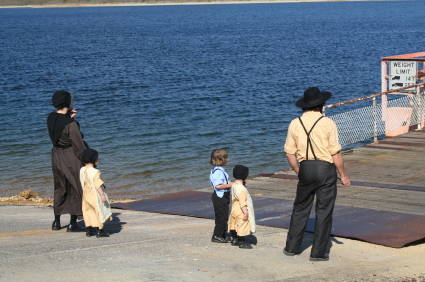தமிழ் கலாச்சாரங்களை தூக்கி சாப்பிட்டு விடுகிற மாதிரி ஒரு கட்டுக்கோப்பான கலாச்சாரத்தோடு, ஆமீஷ் ( Amish) என்ற ஒரு பிரிவினர் (sect) வாழ்ந்து வருகிறார்கள். அவர்களே இங்கே - இதே அமெரிக்காவில் இருக்கும் போது - நாங்கள், நம்மூரு கலாச்சாரத்தைப் பின் பற்ற தடை என்ன? சொல்லுங்க...
அவர்களை பற்றி நிறைய விஷயங்கள் சொல்ல வேண்டியிருப்பதால், காமெடி கீமெடி பண்ணாமல், செய்திகளை மட்டும் இந்த பதிவில், தொகுத்து தந்து இருக்கிறேன்.
Amish Mennonites என்ற ஒரு குழுவினர், கிறிஸ்தவ மார்க்கத்தின் ஒரு சபையை (denomination) சார்ந்தவர்கள். எளிமையான வாழ்க்கை முறை - உடலை முழுவதும் மறைக்கும் எளிய ஆடை - எந்த வித நவநாகரீக தொழில்நுட்ப முறைகளையும் ஏற்று கொள்ளாது, இன்றும் இயற்கையோடு ஒத்து வாழ்பவர்கள்.
1693 ஆம் ஆண்டு, Switzerland ல் Jakob Ammann என்பவரால் தான் இந்த ஆலய சபை முறை ஆரம்பிக்கப்பட்டு இருக்கிறது. ஆமானை பின்பற்றியவர்கள், ஆமிஷ் என்றழைக்கப்பட்டார்கள். அதுவே இன்று வரை தொடர்கிறது.
18 நூற்றாண்டில், இதில் பலர், அமெரிக்காவில் பென்சில்வேனியா ( Pennsylvania ) என்ற மாநிலத்திற்கு வந்து குடியேறி இருக்கிறார்கள். அன்றைய வாழ்க்கை முறையையே இந்த 21 ஆம் நூற்றாண்டிலும் பின்பற்றி வருகிறார்கள். ஆச்சர்யமாக இருக்கிறதா? அமெரிக்காவின் சாயல் இவர்களை பாதிக்கவில்லை.
2010 இல் எடுக்கப்பட்ட கணக்குப் படி, கனடா மற்றும் அமெரிக்கா நாடுகளில் மட்டும் சுமார் 2, 50, 000 ஆமிஷ் மக்கள் இன்னும் அந்த வாழ்க்கை முறைப்படி வாழ்வதாக சொல்கிறார்கள்.
தங்கள் பிரிவைச் சார்ந்தவர்களைத் தவிர, இவர்கள் வேறு யாரையும் திருமணம் செய்து கொள்வதில்லை. இவர்கள் எல்லோரும், அந்த அந்த மாநிலத்தில் ஒரே colony யாக சேர்ந்து வாழ்கிறார்கள். ஒரு காலனி என்பது - 20 - 40 குடும்பங்கள் கொண்டதாக இருக்கும். அடுத்த வீடுகளில் வசித்தாலும், கூட்டு குடும்பத்து முறைப்படி மாதிரிதான், ஒருவருக்கொருவர் ஒத்தாசையாக இருக்கிறார்கள்.
தங்களுக்கு வேண்டிய பெரும்பாலான உணவு தேவைகளை அவர்களே பார்த்துக் கொள்கிறார்கள். கோழி வளர்ப்பு, பால் உற்பத்தி, காய்கறி பயிர் உற்பத்தி எல்லாம் அவர்களின் கைவேலைகளே.
இவர்கள் தச்சு வேலை செய்வதில் வல்லுனர்கள். தங்கள் வீடுகளை, அவர்கள் குழுவினரின் உதவியுடன் தாங்களே கட்டிக் கொள்கிறார்கள். இவர்கள் தச்சு வேலைகள் கொண்டு தயாரிக்கப்பட்ட மர மேஜைகள், நாற்காலிகள் போன்ற பொருட்களை தங்கள் காலனி பக்கமே கடையாக போட்டு விற்கவும் செய்வார்கள். பெண்களும் தையல் குறிப்பாக quilting என்ற கலையில் தேர்ந்த பயிற்சி பெற்றவர்கள்.
இப்படி தனித்து வாழ்வதால், இவர்களுக்கு மற்ற கலாச்சாரத்தைக் கண்டு எந்த வித தூண்டுதலும் (temptation) இருக்காது போல. இவர்கள் வாழ்க்கை முறைக்கு, இவர்கள் நகரங்களில் இல்லாமல் சின்ன சின்ன கிராமங்களில் தான் தங்கி இருக்கிறார்கள்.
அவர்களது மத விதிகள், அவர்களது ஆன்மீக வாழ்க்கைக்கு மட்டும் கட்டுப்படுத்தாது - அவர்களது அன்றாட வாழ்க்கை முறைக்கும் சட்ட திட்டங்களை வகுத்து உள்ளது.
அவற்றில், முக்கிய பத்து விதிகளை உங்களுடன் பகிர்ந்து கொள்கிறேன்:
1. அவர்கள் உடைகள் கவர்ச்சியான நிறத்தில் - முறையில் - இல்லாமல், ( பொதுவாக கருப்பு நிறம், நீல நிறம்) எளிய முறையில் தைத்து இருக்கப்பட வேண்டும்.
ஆமீஷ் இளம்பெண்கள்:
2 . எந்த காரணம் கொண்டும் மின்சாரத்தைப் பயன்படுத்தக் கூடாது. அதனால், எந்த வித நவீன சாதனங்களும் உபயோகிக்க கூடாது. தொலைகாட்சிகள் மற்றும் கம்ப்யூட்டர் கூட இவர்கள் பயன்படுத்துவது இல்லை.
அவர்களின் சமையல் அறை: எல்லாம் வீட்டிலேயே தயார் செய்யப்பட்ட ஜாம் மற்றும் பொருட்கள்:
இவர்கள் செய்யும் ரொட்டிகள் மிகவும் பிரபலமானவை. fridge இல்லாததால், உணவு பதார்த்தங்கள் பதப்படுத்தப்படுகின்றன:
3. கார் போன்ற எந்த வித நவீன பயண வசதிகளையும் பயன்படுத்தக் கூடாது. குதிரைகள் பூட்டப்பட்ட வண்டிகளில் அல்லது சைக்கிள் போன்ற வாகனங்களில் தான் அவர்கள் இன்றும் பயணித்துக் கொண்டு இருக்கிறார்கள். (எங்கள் ஊர்ப் பக்கம் அடிக்கடி பார்த்து இருக்கிறோம். நான் இருக்கிறது ஒரு கிராமம் என்று தெரிந்து போச்சா!)
4. தொலைபேசிகள் மற்றும் அலைபேசிகள் பயன்படுத்தக் கூடாது. சில ஆமீஷ் வியாபாரிகள் (குடும்பங்கள் அல்ல) , சில சமயம் தங்கள் வியாபாரத்துக்கு மட்டும் அலைபேசி சில சமயங்களில் பயன்படுத்துவது பழக்கத்துக்கு வந்துள்ளது.
5. அஹிம்சை முறைகளைத்தான் பின் பற்ற வேண்டும். இதனால், இவர்கள் எந்தவித ராணுவ சேவைகள் செய்வது இல்லை.
6. அதை பின்பற்ற விருப்பமில்லாதவர்கள், ஆமீஷ் வாழ்க்கை முறையை விட்டு விட்டு, அந்த காலனியையும் விட்டு விலகி சென்று விட வேண்டும். அங்கேயே இருந்து கொண்டு புரட்சி செய்கிறேன் என்றெல்லாம் சொல்லக்கூடாது. மீறி, குடும்பத்துடன் தங்க விளைந்தால், சபையே இவர்களை விலக்கி வைத்து விடும். (நம்ம ஊரு பக்கம், ஊரை விட்டு ஒதுக்கி வைத்து விடுவது போல.....)
அவங்களுடைய பார்கிங் லாட்:
7. குழந்தைகளையும் அவர்களே தங்கள் காலனியில் நடத்தும் - ஒரு அறை கொண்ட பள்ளிக்கூடத்திலேயேதான் கல்வி கற்க அனுப்ப வேண்டும். அதுவும் அவர்கள் கல்வி முறை, எட்டாம் வகுப்பு வரை மட்டுமே. அதன் பின், வாழ்க்கை கல்வி என்ற பெயரில் அவர்கள் வாழ்க்கை முறைக்குத் தேவையான விவாசய செய்முறை (usually organic living) - தச்சு வேலைகள் மற்றும் கைவினைப் பொருட்கள் செய்முறை எல்லாம் கற்றுத் தரப்படும்.
குழந்தைகளுக்கு கட்டாய கல்வி முறையை சட்டமாக கொண்டுள்ள அமெரிக்க அரசாங்கம், இவர்கள் குழந்தைகளை , அமெரிக்க கல்விகூடங்களுக்கு அனுப்ப வேண்டும் என்று உத்தரவு போட்ட பொழுது, 1972 ஆம் ஆண்டு, அமெரிக்க சுப்ரீம் நீதிமன்றம், இவர்களின் குழந்தைகளை கட்டாய கல்விக்கு வலியுறுத்துவது, Free Exercise Clause of the First Amendment விதிமுறையை மீறுவதாக அமைந்து விடும் என்று தீர்ப்பு கூறி விட்டது.
8. உலகப் பிரகாரமான கேளிக்கைகள் (சினிமா உட்பட) மற்றும் விளையாட்டுக்கள் எதையும் ஏற்றுக் கொள்ளக் கூடாது. இன்னும் பம்பரம் விடுதல், roller skating போன்ற விளையாட்டுக்கள் தான் இங்கே பிரசித்தம். பொழுதுபோக்கு முறைக்காக, இறைவனைத் துதித்து பாடும் பாடல்களை, அவர்களே கைகளால் செய்யப்பட இசைக்கருவிகள் கொண்டு இசைத்துப் பாடிக் கொள்வார்கள். அதற்கேற்ப, பவ்யமாக ஆடிக் கொள்வார்கள்.
எங்க ஊரு பக்கம் உள்ள ரோடு sign . காரில் வேகமாக வருபவர்கள், கவனமாக ஓட்ட வசதியாக:
9. இயேசு கிறிஸ்துவை மட்டுமே வாழ்கையின் ஆதாரமாக கொண்ட நம்பிக்கை உடையவர்கள். அவர்களுக்கென்று உள்ள ஆலயம் செல்வதும், கூட்டு பிரார்த்தனைகள் செய்வதுமே முதன்மையானதாக கருதப்பட வேண்டும்.
10. பணிவும் அடக்கமுமே ( humility) எப்பொழுதும் மனதில் இருக்க வேண்டும். தலைக்கனம், பெருமை, ஈகோ, பகட்டு எதற்கும் இடம் கொடுக்க கூடாது. எல்லாவற்றிலும் எளிமை வேண்டும்.
இவர்கள் தாங்களாக புகைப்படங்கள் கூட எடுத்து வைத்துக் கொள்வதில்லை. புகைப்படங்கள் எல்லாம், தம்மை அழகாக காட்டிக் கொள்ள தூண்டி விடும் தற்பெருமைக்குள் (personal vanity) தன்னை தள்ளிவிடக் கூடும் என்று கருதுகிறார்கள். இறைவன் படைப்பில், எல்லோரும் அழகானவர்கள் தான் என்று நம்புகிறார்கள்.
மற்றவர்கள் (ஆமீஷ் மக்கள் அல்லாதவர்கள்) தங்கள் ஆல்பத்துக்காக, இவர்களை புகைப்படம் எடுக்க , இவர்கள் சம்மதம் வாங்கி எடுத்துக் கொள்ளலாம்.
ஒருவருக்கொருவர் உதவியாக இருத்தல் - குழந்தைகள் வளர்ப்பில் மற்றும் அன்றாட தேவைகளுக்கு, சமூகமாக ஒன்றுபடல் - இறைவன் ஆராதனை மட்டுமே தங்கள் வாழ்க்கை என்று இருக்கிறார்கள்.
மாட்டுக்குப் பதிலாக குதிரை அல்லது கழுதை வைத்து விவசாயம் நடைபெறுகிறது:
தங்கள் வேலைகள் அனைத்தையும் தாங்களே செய்து கொள்ளும் கட்டுக்கோப்பான வாழ்க்கை முறை கொண்டவர்கள். இன்னும் கடும் உடல் உழைப்புக்கு மட்டுமே முக்கியத்துவம் தருவதால், பொதுவாக மற்றவர்களுக்கு வரும் பெரும்பாலான நோய்கள் இவர்களுக்கு வருவதில்லை. அப்படியே நோய்வாய்ப்பட்டாலும், கைமருத்துவம் தான் நம்பி இருக்கிறார்கள். அதையும் மீறி வரும் பொழுது, இறைவன் சித்தம் என்று ஏற்றுக் கொள்ளும் எண்ணம் கொண்டவர்கள். மிகவும் அபூர்வமாகத் தான் வெளிமருத்தவம் நாடி, அவர்களுக்கென்று சபை சம்மதம் தெரிவித்து உள்ள குறிப்பிட்ட மருத்துவமனைகளுக்கு செல்வது உண்டு.
ஒருவனுக்கு ஒருத்தி என்ற திருமண முறை கொண்டவர்கள். விவாகரத்து என்பதே இவர்களில் கிடையாது.
அவர்களில் ஒருவரை சந்தித்த பொழுது, நவீன வசதிகளை எதற்காக புறக்கணிக்க வேண்டும் என்று கேட்டோம். அவர் சொன்ன பதிலில் இருந்து நான் இன்னும் மீளவில்லை:
" நவீன வசதிகள் எல்லாம் - மின்சாரம் பயன்படுத்துவது உள்பட - மனிதர் ஒவ்வொருவரையும் தனித்தன்மையுடன் இயங்கச் செய்ய வைப்பதாகவே உள்ளது. (It encourages independent style of living.) எங்கள் சமூகத்தை சார்ந்து வாழும், கூட்டு வாழ்க்கை முறையை விட்டு விட்டு, தனி மனித - தனி குடும்ப வசதி முறைக்கே முக்கியத்துவம் கொடுப்பதாக மாற்றி விடக் கூடியதாக உள்ளது. அது மட்டும் அல்ல, அந்த பொருட்கள் நம்மை அடிமையாக்கி, நம் குடும்பங்கள் - நம் சந்தோசம் - என்று நினைப்பதை விட்டு விட்டு, என் குடும்பம் - என் சந்தோசம் - என்ற குறுகிய வட்டத்துக்குள் நம்மை கொண்டு சென்று விடக் கூடும். எனது அடுத்த வீட்டாருடன், சகோதரத்துவ குணத்துடன் பழக வைக்க விடாமல், அவர்களையே என் போட்டியாளர்களாக கருத வகை செய்து விடும். அந்த பொருட்களை பயன்படுத்துவது, நமது வசதிகளைப் பெருக்குவதாக முதலில் தோன்றினாலும், நமது பணத்தேவைகளையும் அதை விட பலமடங்கு பெருக்கி, எளிய வாழ்க்கை முறையில் கிடைக்கும் மகிழ்ச்சி - நிம்மதி கிடைக்க வழியில்லாமல் செய்து விடும், "


























